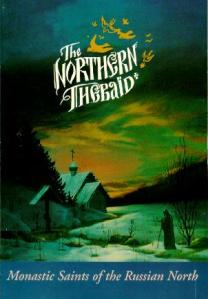Christ is Risen! Indeed He is Risen!
I hope and trust we have all had a soul-profiting Lent and Holy Week, and a radiant Pascha and Easter…
 What better way to return to blogging on the North American Thebaid than to share the life of St Nilus of Sora, whom we just commemorated on May 7.
What better way to return to blogging on the North American Thebaid than to share the life of St Nilus of Sora, whom we just commemorated on May 7.
In the Russian Northern Thebaid, Venerable Nilus established the way of skete life, which is often considered the ‘Royal Way’ between the solitary monastic life (eremitic) and communal (cenobitic). In skete life, anywhere from a few to several monks or nuns live in their own separate cells or huts, within shouting distance of one another (in case of emergency), and then join together for the divine services for the Lord’s Day and on major feasts and saints’ days. During the week, they keep their monastic prayer rule and work at their crafts and obediences to help sustain the Skete.
Skete life shows the wisdom of the monastic way, as not everyone is suited for close living in community, and only a very few are called to life as a hermit, in complete solitude. It may very well be that here in North America, where we all have become accustomed to living such individualized, idiosyncratic lives, that skete life will be a real option for many monastics as the North American Thebaid grows and matures (should the Lord not return first).
Repose of the Venerable Nilus the Abbot of Sora
OCA, May 7, 2017:
 Saint Nilus of Sora, a great ascetic of the Russian Church, was descended from the Maikov nobility. He accepted monasticism at the monastery of Saint Cyril of White Lake (June 9). Here he made use of the counsels of the pious Elder Paisius Yaroslavov, who was afterwards igumen of the Trinity-Sergiev Lavra.
Saint Nilus of Sora, a great ascetic of the Russian Church, was descended from the Maikov nobility. He accepted monasticism at the monastery of Saint Cyril of White Lake (June 9). Here he made use of the counsels of the pious Elder Paisius Yaroslavov, who was afterwards igumen of the Trinity-Sergiev Lavra.
Saint Nilus journeyed much through the East, studying the monastic life in Palestine and on Mt. Athos. Returning to Rus, he withdrew to the River Sora in the Vologda lands, and built a cell and a chapel, where there soon grew up a monastery with a new (for that time in Rus) skete Rule adopted by Saint Nilus from Mt. Athos. Following the command of Saint Nilus, the monks had to sustain themselves by the work of their own hands, to accept charity only in extreme need, and to shun the love of things and splendor even in church. Women were not permitted in the skete, monks was not allowed to leave the skete under any pretext, and the possession of lands or estates was forbidden.
The monks lived in the forest around the small church in honor of the Meeting of the Lord, in separate cells of one or two but not more than three men. They gathered together in church for divine services. Moreover, readings from the holy Fathers were prescribed at the All-Night Vigil, which actually lasted the whole night. On other days, each one prayed and worked in his own cell.

The saint struggled constantly with his own thoughts and passions. Then peace would be born in his soul, clarity in his mind, contrition and love in his heart. In his written works, “A Tradition for my Disciple, Wishing to Live in the Wilderness,” and the “Rule,” Saint Nilus describes the steps of this salvific mental activity in detail. The first step is renunciation of the world, particularly, from every worldly distraction. The second is unceasing prayer, accompanied by the remembrance of death.
The saint was distinguished for his non-possessiveness and love for work. He dug a pond and a well, whose water had healing power. For his sanctity of life the Elder Nilus was deeply venerated by the Russian hierarchs of his time. He participated in the Councils of 1490 and 1503. Disdaining the honors and glories of this world, he told his disciples before his death either to throw his body to be eaten by beasts and birds, or to bury it without honor at the place of his struggles.
The saint died in his seventy-sixth year of life, on May 7, 1508. His relics, buried in the monastery he founded, were glorified by many miracles. The Russian Church has numbered him among the saints.
One collection of Venerable Nilus’ writings describes him as “an influential spiritual writer whose major contribution to Eastern Christianity was his bringing to ancient Russia the spirituality of the early Fathers and Mothers of the Desert. This is called the hesychasm spirituality of the heart, which finds the perfection of the human person in union with God through continuous prayer.”
Suggested Books:
 The Northern Thebaid: Monastic Saints of the Russian North, St Herman Press
The Northern Thebaid: Monastic Saints of the Russian North, St Herman Press
Nil Sorsky: The Complete Writings (Classics of Western Spirituality)

Pingback: Venerable Pachomius the Great, Founder of Coenobitic Monasticism – The North American Thebaid